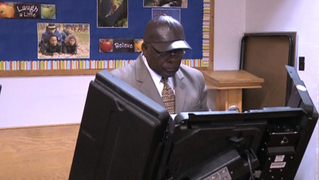
Guests
- Kara Danskysenior counsel for the American Civil Liberties Union and author of their new report, “The War Comes Home: The Excessive Militarization of American Policing.”
President Obama has ordered a White House-led review of federal programs that fund and distribute military equipment to state and local police. Obama cited concern at how such equipment was used during the recent unrest in Ferguson, Missouri, following the police killing of Michael Brown. One of the BearCat armored trucks used during protests there was paid for with $360,000 in Homeland Security grants. According to Pentagon data published by The New York Times, police departments have received tens of thousands of machine guns during the Obama administration, along with nearly 200,000 ammunition magazines; thousands of pieces of camouflage and night-vision equipment; and hundreds of silencers, armored cars and aircraft. Much of the equipment is used by police SWAT teams for what amount to paramilitary raids on people’s homes. A new report by the American Civil Liberties Union examined more than 800 of these raids and found only 7 percent were for genuine emergencies. Nearly 80 percent were for used for ordinary law enforcement purposes like serving search warrants on people’s homes. We are joined by Kara Dansky, a senior counsel for the ACLU and author of its new report, “The War Comes Home: The Excessive Militarization of American Policing.”
Transcript
JUAN GONZÁLEZ: This week, President Obama ordered a White House-led review of federal programs that fund and distribute military equipment to state and local police. He cited concern at how such equipment was used during the protests in Ferguson, Missouri, after the police shooting of Michael Brown. One of the BearCat armored trucks used during those protests was paid for with $360,000 in Homeland Security grants.
PRESIDENT BARACK OBAMA: There is a big difference between our military and our local law enforcement, and we don’t want those lines blurred. That would be contrary to our traditions. And I think that there will be some bipartisan interest in re-examining some of those programs.
AMY GOODMAN: According to Pentagon data published by The New York Times, police departments have received tens of thousands of machine guns during the Obama administration, along with nearly 200,000 ammunition magazines; thousands of pieces of camouflage and night-vision equipment; and hundreds of silencers, armored cars, aircraft. Much of the equipment is used by police SWAT teams for what amount to paramilitary raids on people’s homes.
A new report by the American Civil Liberties Union examined more than 800 of these raids and found only 7 percent were genuine emergencies. Nearly 80 percent were used for ordinary law enforcement purposes, like serving search warrants on people’s homes. The report is called “The War Comes Home: The Excessive Militarization of American Policing.” We’re joined now from Washington, D.C., by its author, Kara Dansky, senior counsel for the ACLU.
Welcome to Democracy Now!, Kara. What surprised you most by what’s happening? And if you could relate what is becoming an awareness in the mainstream media, that many in different communities have talked about for a while, the militarization of police? Ferguson has really brought it, exploded it onto the national media scene.
KARA DANSKY: Sure. Thanks for having me, first of all. And, you know, Amy, I think that’s exactly right. I think that what has shocked so many Americans who are watching what happened in Ferguson is something that really reflects a much broader trend, which is the militarization of policing, which, as you say, has been going on in certain communities in the United States for decades, fueled in large part by a series of federal programs that bring weapons and money to local law enforcement, mainly to wage the war on drugs, which has been unfairly and aggressively fought in communities of color, as I said, for decades. So, I do think that what we saw in Ferguson is shocking, and I’m encouraged that more and more people are coming to understand this phenomenon of militarization of policing, but I think it’s also important to understand that it does reflect a much broader trend that’s been going on in America for quite some time.
JUAN GONZÁLEZ: Well, Kara Dansky, there have been generations now of conflicts between urban police departments and minority communities in the United States. But as your report seems to point out, it’s the weaponry that has changed, not the actual conflicts.
KARA DANSKY: Well, certainly the weaponry has changed quite a bit in terms of the kinds of weaponry that Amy listed early on that the police are able to get free of charge from the Pentagon, through what is known as the 1033 program, and also the kinds of weaponry that local police are able to buy directly from weapons manufacturers with money that they receive from the Department of Justice and the Department of Homeland Security. I think that that’s right. I think that the kinds of weapons has certainly evolved and expanded in terms of what local police have access to and the kinds of weapons that they use in their arsenals. And it’s also true, as you say, that aggressive policing has been going on for a long time in communities of color. I also think that the militarization trend reflects not only the kinds of equipment, but also a certain culture of militarism that we see permeating many police departments throughout the country.
AMY GOODMAN: This month, Pentagon spokesperson Rear Admiral John Kirby responded to criticism of the militarization of police through equipment transfers from the Defense Logistics Agency.
REAR ADM. JOHN KIRBY: I will tell you, though, that we have rigorous compliance and accountability standards. And biannually, the Defense Logistics Agency spot-checks many of these local law enforcement agencies in the states to make sure that they’re keeping proper accountability, inventorying, keeping an inventory of the equipment. But we do not legislate, we don’t dictate, we don’t—we don’t mandate any kind of certain use. That is up to local law enforcement.
AMY GOODMAN: That is Pentagon spokesperson Rear Admiral John Kirby. Kara Dansky, your response?
KARA DANSKY: Well, that’s exactly right, and it’s a big part of the problem. We don’t think that the local police should be able to have unlimited discretion in terms of how they deploy military weaponry in American communities. The other thing that’s important to note is it is true that the Defense Logistics Agency is required to do some checks in terms of overseeing the inventory to make sure that local police departments are keeping track of the kinds of weapons that they get from the Pentagon. But it raises a question as to what happens when those inventories aren’t completed or when weapons go missing. We know that a number of police departments across the country have been suspended from the program because they simply can’t account for some of the weapons that they got from the Pentagon. It’s appropriate to have that kind of oversight and to suspend departments that can’t account for the weapons they get from the Pentagon, but it raises a really important question, which is: What happened to those weapons?
JUAN GONZÁLEZ: I wanted to ask you about some of these examples that your report cites. For example, if you could talk about the toddler who was severely injured in May in Georgia?
KARA DANSKY: Sure, Juan. This is a really horrifying case of something that happens routinely across the country, usually not resulting in that kind of injury. But basically what happened was a family was visiting extended family in a small town outside of Atlanta, Georgia. They were asleep. It was about 3:00 in the morning. And the police decided to serve a search warrant on the home where they were staying, and they served that warrant at 3:00 in the morning. And it’s important to note, they were looking for a man that they suspected of having about $50 worth of drugs. They served the search warrant at about 3:00 in the morning, and they used what’s called a flashbang grenade. This is a grenade that detonates a loud noise. There’s an explosion, and it causes temporary blindness and deafness, as well as tremendous confusion by the people who experience it.
And this flashbang grenade landed directly in the crib of sleeping Bou Bou Phonesavanh, critically injuring him. It was absolutely horrific. His sisters were in the room and watched this happen and experienced the detonation of the flashbang grenade. And then the officers came in, and they held the family at gunpoint. When Bou Bou’s mother tried to go to him, they yelled at her to shut up and get on the ground. They held the family at gunpoint. They ordered Bou Bou’s father to the ground. They held him there. And then it was hours before these parents were able to see their child.
So, again, tragedies like that don’t happen every day, but the kinds of tactics and weapons that are being deployed by the police in the kinds of raids that we saw happen in Georgia are happening every day in America.
AMY GOODMAN: Kara Dansky, we want to thank you very much for being with us,
senior counsel for the American Civil Liberties Union and author of the new
report, “The War Comes Home: The Excessive Militarization of American Policing.” We’ll link to it at democracynow.org.












Media Options